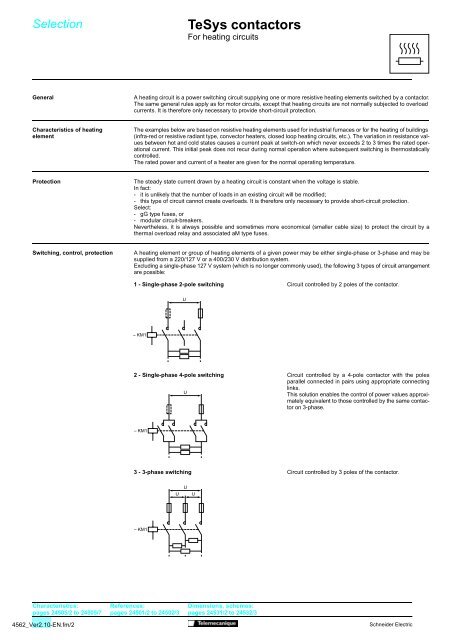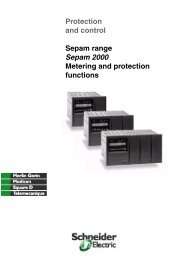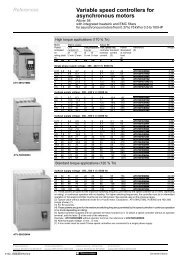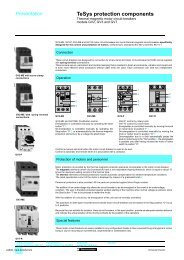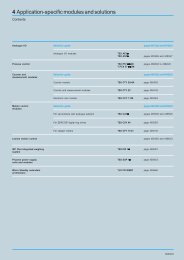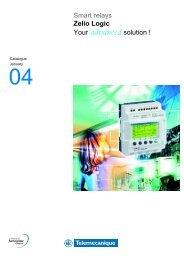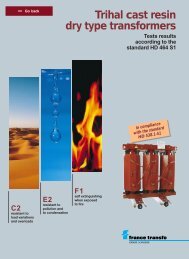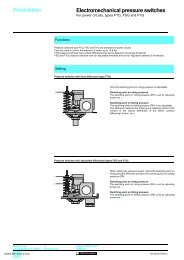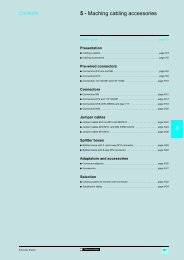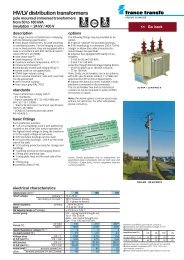TeSys protection components - Trinet
TeSys protection components - Trinet
TeSys protection components - Trinet
Create successful ePaper yourself
Turn your PDF publications into a flip-book with our unique Google optimized e-Paper software.
Selection<br />
<strong>TeSys</strong> contactors<br />
For heating circuits<br />
General<br />
A heating circuit is a power switching circuit supplying one or more resistive heating elements switched by a contactor.<br />
The same general rules apply as for motor circuits, except that heating circuits are not normally subjected to overload<br />
currents. It is therefore only necessary to provide short-circuit <strong>protection</strong>.<br />
Characteristics of heating<br />
element<br />
The examples below are based on resistive heating elements used for industrial furnaces or for the heating of buildings<br />
(infra-red or resistive radiant type, convector heaters, closed loop heating circuits, etc.). The variation in resistance values<br />
between hot and cold states causes a current peak at switch-on which never exceeds 2 to 3 times the rated operational<br />
current. This initial peak does not recur during normal operation where subsequent switching is thermostatically<br />
controlled.<br />
The rated power and current of a heater are given for the normal operating temperature.<br />
Protection<br />
The steady state current drawn by a heating circuit is constant when the voltage is stable.<br />
In fact:<br />
- it is unlikely that the number of loads in an existing circuit will be modified;<br />
- this type of circuit cannot create overloads. It is therefore only necessary to provide short-circuit <strong>protection</strong>.<br />
Select:<br />
- gG type fuses, or<br />
- modular circuit-breakers.<br />
Nevertheless, it is always possible and sometimes more economical (smaller cable size) to protect the circuit by a<br />
thermal overload relay and associated aM type fuses.<br />
Switching, control, <strong>protection</strong><br />
A heating element or group of heating elements of a given power may be either single-phase or 3-phase and may be<br />
supplied from a 220/127 V or a 400/230 V distribution system.<br />
Excluding a single-phase 127 V system (which is no longer commonly used), the following 3 types of circuit arrangement<br />
are possible:<br />
1 - Single-phase 2-pole switching Circuit controlled by 2 poles of the contactor.<br />
U<br />
– KM1<br />
2 - Single-phase 4-pole switching Circuit controlled by a 4-pole contactor with the poles<br />
parallel connected in pairs using appropriate connecting<br />
links.<br />
U<br />
This solution enables the control of power values approximately<br />
equivalent to those controlled by the same contactor<br />
on 3-phase.<br />
– KM1<br />
3 - 3-phase switching Circuit controlled by 3 poles of the contactor.<br />
U<br />
U<br />
U<br />
– KM1<br />
Characteristics:<br />
pages 24505/2 to 24505/7<br />
References:<br />
pages 24501/2 to 24502/3<br />
Dimensions, schemes:<br />
pages 24531/2 to 24532/3<br />
4562_Ver2.10-EN.fm/2<br />
Schneider Electric


